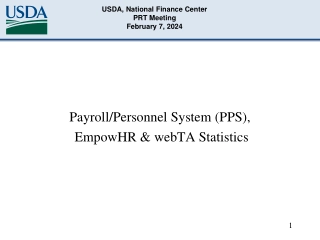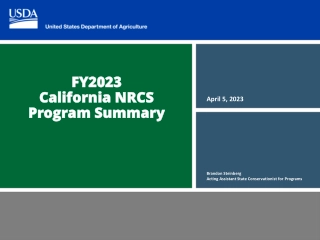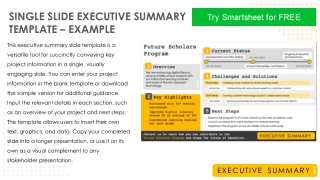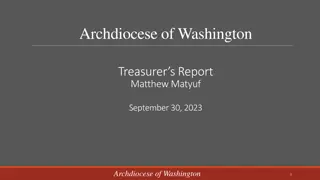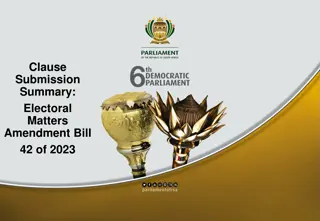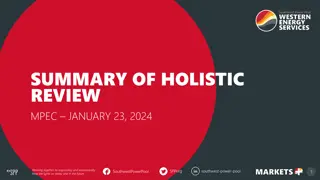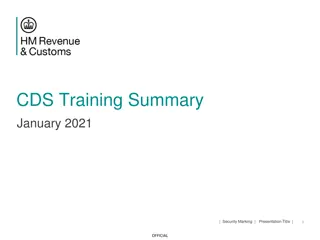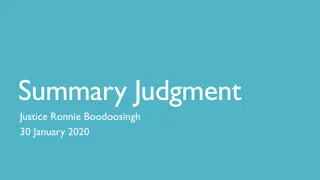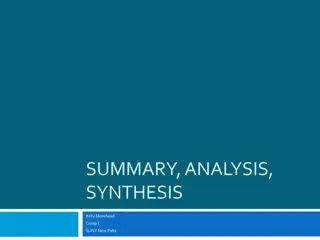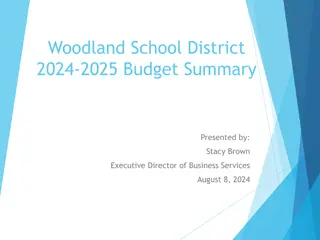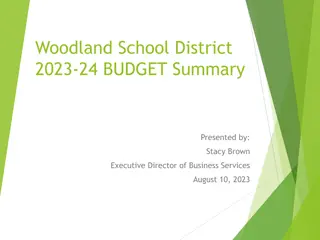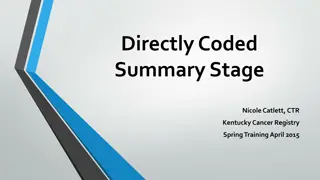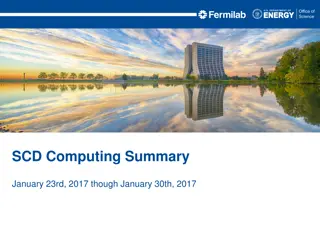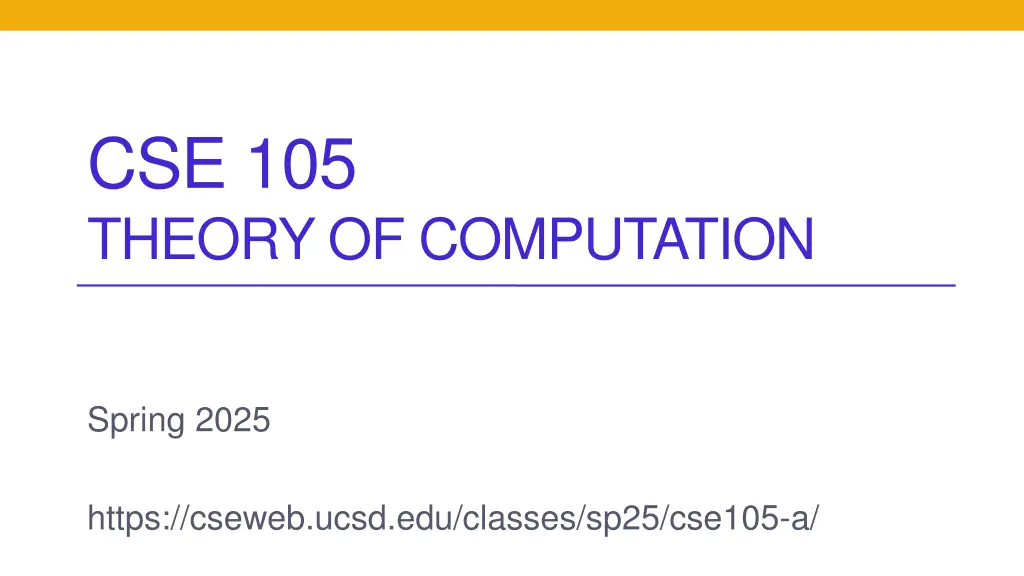
Computation Theory: Key Concepts, Final Exam Preparation, and Next Steps
Explore essential topics in CSE 105 Theory of Computation for Spring 2025, covering recognizable, decidable, NP, P, CF, regular languages, models of computation, closure properties, and more. Enhance your understanding of formal definitions, language description, automata, and Turing Machines to excel in your studies and exam. Discover the roadmap of examples, strategies for proving regularity, and practical examples to solidify your knowledge. Unveil what lies ahead in computability and complexity theory, urging you to delve deeper into the world of computational sciences.
Download Presentation

Please find below an Image/Link to download the presentation.
The content on the website is provided AS IS for your information and personal use only. It may not be sold, licensed, or shared on other websites without obtaining consent from the author. If you encounter any issues during the download, it is possible that the publisher has removed the file from their server.
You are allowed to download the files provided on this website for personal or commercial use, subject to the condition that they are used lawfully. All files are the property of their respective owners.
The content on the website is provided AS IS for your information and personal use only. It may not be sold, licensed, or shared on other websites without obtaining consent from the author.
E N D
Presentation Transcript
CSE 105 THEORY OF COMPUTATION Spring 2025 https://cseweb.ucsd.edu/classes/sp25/cse105-a/
Today's learning goals Summarize key concepts, ideas, themes from CSE 105. Approach your final exam studying with confidence. Identify areas to focus on while studying for the exam.
Recognizable Decidable NP? P CF Regular
Model of computation Formal definition? Design? Describe language? Finite automata -- DFA -- NFA equiv to Regular expressions Push-down automata CFGs TMs that always halt in polynomial time Class of languages Closure properties? Which languages not in class? Regular languages To show not in class: Pumping lemma Context-free languages P Nondeterministic TMs that halt in polynomial time NP TMs that always halt aka Deciders Decidable languages To show not in class: Diagonalization, reduction Recognizable languages Turing Machines (in general; may not halt)
Where to next? This class: computability theory what can be computed in finite time CSE 200: complexity theory ok, finite, but how fast? How much memory? More about reductions, non- determinism, non-uniformity, interactive protocols, Yes, it s a grad class, but if you liked what you saw here, you should take it.
Roadmap of examples A. Regular language design B. Undecidability via reduction C. Closure proofs D. Determining the language of a PDA /CFG E. Using Pumping Lemma
Given L, prove it is regular Construction Strategy 1: Construct DFA Strategy 2: Construct NFA Strategy 3: Construct regular expression Proof of correctness WTS 1if w is in L then w is accepted by . WTS 2if w is not in L then w is rejected by
Ex: L= { w in {0,1}* | w has odd # of 1s OR starts with 0} NFA: Regular expression:
To show a language is not regular, we can A. Show there is a CFG generating A. B. Use the pumping lemma for regular languages. C. Show A is undecidable. D. More than one of the abve. E. I don't know.
To show a language L is Recognizable Show there is a TM M with L(M) = L. Not recognizable Prove that L is not decidable and that the complement of L is recognizable. Use closure properties. Use closure properties.
To show a language L is Decidable Show there is a TM D that always halts and L(D) = L. Not decidable Use diagonalization Find an undecidable problem L' and show L' reduces to L. Find a decidable problem L' and show L reduces to L' Use closure properties. Use closure properties.
Undecidability via reduction Theorem: Problem T is undecidable. Proof Common pattern for many of these proofs. Assume (towards a contradiction) that T is decidable by TM MT. Goal: use MT to build a machine which will decide ATM. Define MATM = "On input <M,w>: 1. Using the parameters M and w, construct a different TM X such that if M accepts w, then <X> is in T; if M does not accept w, then <X> is not in T. 2. Run MT on <X> and accept if MT accepts, reject if MT rejects." Claim: MATM is decider and L(MATM) = ATM, Then ATM is decidable, contradicting the known fact that ATM is undecidable.
T = { <M> | M is TM and |L(M)| = 1} Theorem: Problem T is undecidable. Proof Assume (towards a contradiction) that T is decidable by TM MT. Goal: use MT to build a machine which will decide ATM. Define MATM = "On input <M,w>: 1. Using the parameters M and w, construct a different TM X such that if M accepts w, then <X> is in T; if M does not accept w, then <X> is not in T. 2. Run MT on <X> and accept if accepts, reject if rejects. Claim: MATM is decider and L(MATM) = ATM, Then ATM is decidable, contradicting the known fact that ATM is undecidable.
Undecidability via reduction Theorem: Problem T is undecidable. Proof Common pattern for many of these proofs. Assume (towards a contradiction) that T is decidable by TM MT. Goal: use MT to build a machine which will decide ATM. Define MATM = "On input <M,w>: 1. Using the parameters M and w, construct a different TM X such that if M accepts w, then <X> is in T; if M does not accept w, then <X> is not in T. 2. Run MT on <X> and accept if accepts, reject if rejects. Claim: MATM is decider and L(MATM) = ATM, Then ATM is decidable, contradicting the known fact that ATM is undecidable. E. I don't know. In reduction proofs, A. We always need to build a new TM X. B. The auxiliary machine X must be run as part of our algorithm. C. The auxiliary machine X runs only on w. D. None of the above.
Countable and uncountable Countable Find bijection with N Find a countable superset Examples Any language over Set of all regular languages Set of rational numbers Set of integers Uncountable Diagonalization Find an uncountable subset Examples Set of all subsets of * Set of infinite binary sequences Set of real numbers [0,1]
Closure properties Regular Languages CFL Decidable Languages Recognizable Languages Union Intersection Complement Star Concatenation
Proving closure Goal: "The class of ____ languages is closed under _____" In other words Given a language in specific class, is the result of applying the operation _____ to this language still guaranteed to be in the class?
Proving closure Given: What does it mean for L to be in class? e.g. L a regular language, so given a DFA ML = (QL, L, L,qL,FL) with L(ML) = L. Name each of the pieces! WTS: The result of applying the operation to L is still in this class. Construction: Build a machine that recognizes the result of applying the operation to L. Start with description in English! e.g. Let M = (Q, , , q0, F) where Q= = = q0= F=.. M could be DFA or NFA Correctness: Prove L(M) = result of applying operation to L WTS1 if w is in set then w is accepted by M WTS2 if w is not in the set then w rejected by M.
Claim: The class of recognizable languages is closed under concatenation Given WTS Construction Correctness
Claim: The class of recognizable languages is closed under concatenation Given Two recognizable languages A,B and TMs that recognize them: MA with L(MA) = A and MB with L(MB) = B. WTS The language AB is recognizable. Construction Define the TM M as "On input w, 1. Nondeterministically split w into w = xy. 2. Simulate running MA on x. If rejects, reject; if accepts go to 3. 3. Simulate running MB on y. If rejects, reject; if accepts, accept. Correctness
Construction Define the TM M as "On input w, 1. Nondeterministically split w into w = xy. 2. Simulate running MA on x. If rejects, reject; if accepts go to 3. 3. Simulate running MB on y. If rejects, reject; if accepts, accept. Correctness Claim that w is in AB iff w is in L(M). Part 1: Assume w is in AB. Then there are strings x,y such that w = xy and x is in A, y is in B. Running M on w, one of the nondeterministic ways we split w will be into these x,y. In step 2, the computation of MA on x will halt and accept (because L(MA) = A) so we go to step 3. In that step, the computation of MB on y will halt and accept (because L(MB) = B so M accepts w.
Construction Define the TM M as "On input w, 1. Nondeterministically split w into w = xy. 2. Simulate running MA on x. If rejects, reject; if accepts go to 3. 3. Simulate running MB on y. If rejects, reject; if accepts, accept. Correctness Claim that w is in AB iff w is in L(M). Part 2: Assume w is not in AB. Then there are no strings x,y such that w = xy and x is in A, y is in B. In other words, for each way of splitting w into xy, at least one of the following is true: MA running on x will reject or loop, MB running on y will reject or loop. Tracing the computation of M on w, in each one of the nondeterministic computation paths, there is some split w=xy. For each of these splits, in step 2, the computation of MA on x either loops (in which case M loops on w, so w is not in L(M)) or rejects (in which case M rejects w) or accepts (in which case M goes to step 3). If the computation of M enters step 3, this means that x is in L(MA) so by our assumption, y is not in L(MB) so MB on y must either loop or reject. In either case, M rejects. Thus w is not in L(M).
Proving closure Given: What does it mean for L to be in class? e.g. L a regular language, so given a DFA ML = (QL, L, L,qL,FL) with L(ML) = L. Name each of the pieces! WTS: The result of applying the operation to L is still in this class. Construction: Build a machine that recognizes the result of applying the operation to L. Start with description in English! e.g. Let M = (Q, , , q0, F) where Q= = = q0= F=.. M could be DFA or NFA Correctness: Prove L(M) = result of applying operation to L WTS1 if w is in set then w is accepted by M WTS2 if w is not in the set then w rejected by M. To prove the class of recognizable languages is closed under _____ the constructions may involve building a A. Two-tape Turing machine. B. Nondeterministic decider. C. Enumerator. D. All of the above. E. I don't know.
Claim: The class of decidable languages is closed under reversal Given WTS Construction Correctness
Claim: The class of decidable languages is closed under reversal Given A decidable language L, with a decider TM D: L(D)=L WTS There is a decider that decides LR = {w | wR is in L} Construction Define the TM M as "On input w: 1. Make a copy of w in reverse. 2. Simulate running D on this copy. 3. If D accepts, accept. If D rejects, reject. Correctness If w is in LR then in step 1, M builds wR and in step 2, the computation of D on wR will accept (because L(D) = L), so in step 3, M accepts w. If w is not in LR then in step 1, M builds wR and in step 2, the computation of D on wR will rejept (because L(D) = L), so in step 3, M rejects w.
Claim: The class of decidable languages is closed under reversal Given A decidable language L, with a decider TM D: L(D)=L WTS There is a decider that decides LR = {w | wR is in L} Construction Define the TM M as "On input w: 1. Make a copy of w in reverse. 2. Simulate running D on this copy. 3. If D accepts, accept. If D rejects, reject. Correctness If w is in LR then in step 1, M builds wR and in step 2, the computation of D on wR will accept (because L(D) = L), so in step 3, M accepts w. If w is not in LR then in step 1, M builds wR and in step 2, the computation of D on wR will rejept (because L(D) = L), so in step 3, M rejects w. automata. D. I don't know. Is this how we proved that the class of regular languages is closed under reversal? A. Yes. B. No but we could modify our earlier proof to make a copy of wR and then run the DFA on it. C. No and this strategy won't work for
What is the language of this PDA? A. {w | # of b's in w # of a's in w} B. {w | w = anbn+1for some n 0} C. {w | w = anbn+2for some n 0} D. {w | w = anb2nfor some n 0} E. {w | w = 0anb2n0 for some n 0}
What is the language of CFG with rules S aSb | bY | Ya Y bY | Ya |
(Using) Pumping Lemma Theorem: L = {w wR | w is in {0,1}* } is not regular. Proof (by contradiction): Assume, towards a contradiction, that L is regular. Then by the Pumping Lemma, there is a pumping length, p, for L. Choose s to be the string ________. The Pumping Lemma guarantees that s can be divided into parts s=xyz such that |xy| p, |y|>0, and for any i 0, xyiz is in L. But, if we let i=____, we get the string ______ which is not in L, a contradiction. Thus L is not regular.
(Using) Pumping Lemma A. s = 000000111111, i=6 B. s=0p0p, i=2 C. s=0p110p, i=2 D. More than one of the above. E. I don't know. Theorem: L = {w wR | w is in {0,1}* } is not regular. Proof (by contradiction): Assume, towards a contradiction, that L is regular. Then by the Pumping Lemma, there is a pumping length, p, for L. Choose s to be the string ________. The Pumping Lemma guarantees that s can be divided into parts s=xyz such that |xy| p, |y|>0, and for any i 0, xyiz is in L. But, if we let i=____, we get the string ______ which is not in L, a contradiction. Thus L is not regular.
P and NP P: Languages decidable in polynomial time on deterministic Turing machines. e.g. PATH, Simple arithmetic, CFL's, etc. NP: Languages decidable in polynomial time on nondeterministic Turing machines. e.g. TSP, SAT, CLIQUE, etc. Know P NP and if an NP-complete problem is in P, then P=NP.
Recognizable Decidable NP? P CF Regular


